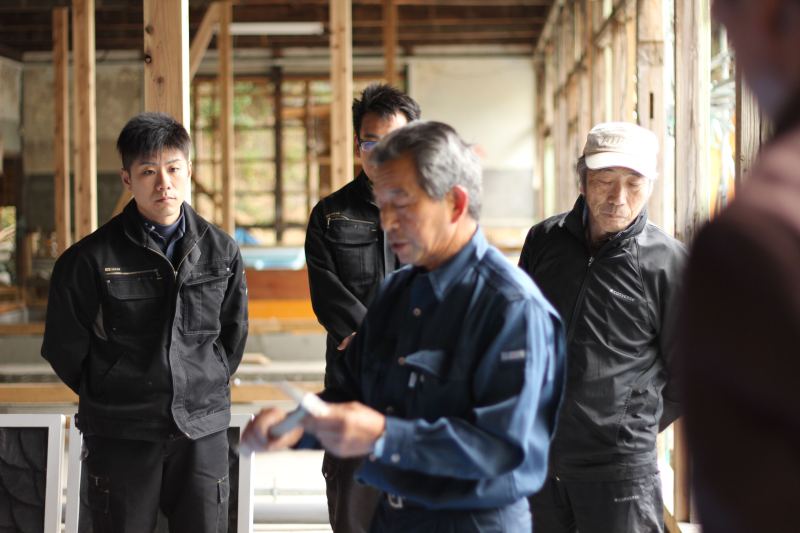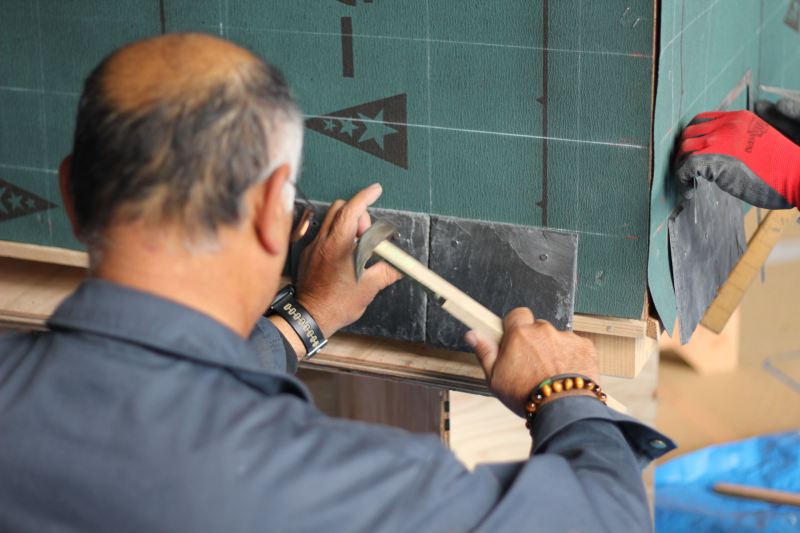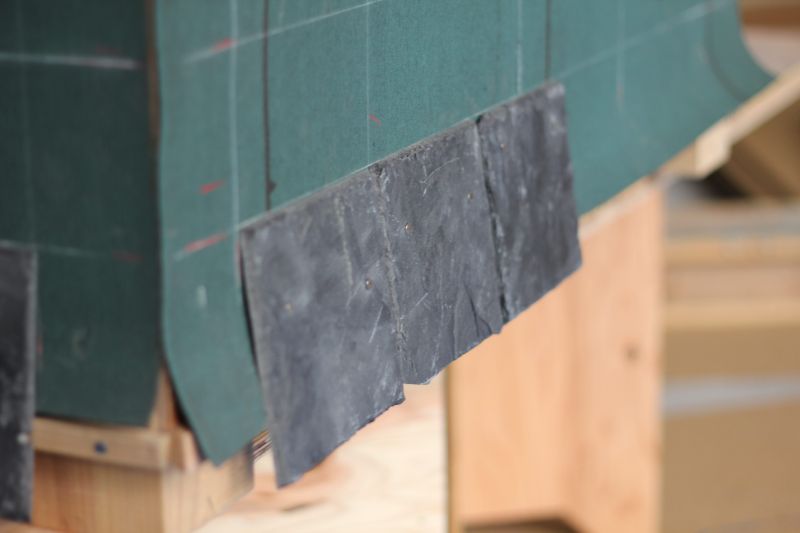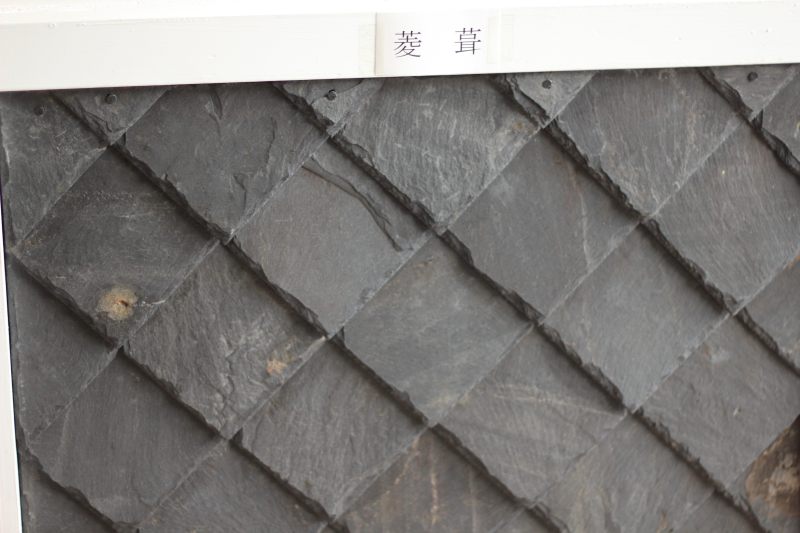石盤葺(せきばんぶき)
Sekiban Thatched Roofs (Sekibanbuki)
平成26年11月9日、宮城県石巻市雄勝町にある旧桑浜小学校で行われた「石盤葺講習会」に参加してきました。
On November 9, 2014 we participated in the Sekibanbuki workshop at the old Kuwanohama elementary school in Ishinomaki City, Ogachi-cho, which is in Miyagi Prefecture.
石盤葺(せきばんぶき)は、薄く割った粘板岩(玄昌石)の板を屋根に葺く技術で、明治時代の後半から大正時代にかけて洋風建築の屋根葺き材として積極的に採用され、スレート葺、天然スレート葺とも呼ばれています。粘板岩は国内各地で産するが、なかでも宮城県石巻市の雄勝産が良品とされ、文化財建造物修理で使用される石盤の大半が雄勝産です。(資料参考)
Sekibanbuki is an art/technology that uses thin slices of Genshoseki (a type of stone) for making a roof. It was employed from the second half of the Meiji era (1868-1912) to the Taisho era (1912-1926) and used to make the roofs on a lot of western style buildings. It is called natural Suretobuki (slate roofs). Ogatsu, Ishinomaki is considered one of the best places where this stone is produced. The stones from Ogatsu are used in cultural heritage buildings around the country.
最近では、震災後、東京駅 赤れんが駅舎の屋根がこの技術を使って修復されました。
Recently, after the (Great East Japan) earthquake, the roof of the famous red brick building of Tokyo Station was repaired using this art (Ogatsu Sekibanbuki).
修復作業では、屋根約20万枚を丁寧に全部外し、石巻に持って帰りました。そして、1枚ずつ割れ目などがないか調べ、汚れをとって、再び使えるものと使えないものとに分け、作業が終わったものから納品していました。最後の6万5千枚が出荷される直前に、東日本大震災が起き、津波によって全て流されましたが、職人さんたちの手でなんとか拾い集められ、一枚一枚丁寧に洗い、検品し、再び出荷されていったとお話ししてくださいました。
The repair work involved 200,000 tiles of stone for the roof, which were all transported from Ishinomaki. (Volunteers and professional Sekibanbuki experts came to help recover stones from the houses that were destroyed in the tsunami.) Each stone was checked, washed, and separated for reuse. When this was finished, the stones were transported. 65,000 stones were determined to be reusable and shipped to Tokyo (along with some additional new stones).
「雄勝学校再生プロジェクト」の桑浜小学校も、この技術が使われており、昨年、修復作業が行われました。
“The Ogatsu Gakko Saisei (School Reuse) Project” is focused on Kuwanohama elementary school. Since last year, they have been using this (Sekibanbuki) technology to repair the roof.
そして、今回はこの石盤葺の技術を伝えるワークショップがおこなわれました。
This workshop was made to show how the Sekibanbuki technology works.
佐々木さんがこの石盤葺の葺く方法を丁寧に教えてくださいました。まずは、屋根(または壁)のどこに葺いていくかを丁寧に図っていきます。
Sasakisan was pleased to tell us about how to make the Sekibanbuki. First of all, the roof (or a wall) is carefully measured to determine where to place the stones.
そしてその大きさに石を切ったり削ったりし、
(石の目を見分けて切るのが難しい作業です。)
From there, the stones are cut and shaved to be the right size and design.
It is a difficult task to distinguish by eye the places to cut the stone.
厚さをできるだけ揃えながら釘で打ち止めて葺いていきます。
The thickness is determined, a hole is drilled, and the stone is attached to the wall or roof.
このように、一文字葺、鱗葺(うろこぶき)、菱葺(ひしぶき)、亀甲葺(きっこうぶき)、蛤葺(はまぐりぶき)などの種類があるそうです。
In this picture you can see the various kinds of tiles: Ichimonji Buki (straight-edged tile), Uroko Buki (a scaled tile), Hishi Buki (a diamond tile), Kikko Buki (turtle backed tile), and Hamaguri Buki (a shell shaped tile).
2005年、宮城県の佐々木伸平さんが石盤葺の国選定保存技術者として認定されましたが、後継者不足や材料の入手が困難なことが、この技術を保存していく大きな課題となっています。
In 2005, Miyagi Prefecture certified Sasaki Shinpei as a nationally recognized technician for the conservation of Sekibanbuki technology. However, there is a shortage of materials and successors who can follow in his footsteps. A major challenge now is to find a way to save Sekibanbuki technology.少しでも多くの方にこのような技術を知ってもらい、文化を残していくことが、過疎化の進む今の日本では重要な課題の一つとなっています。
Little by little, (thanks to Sasaki Shinpei) people are learning this technique again. Otherwise, with the problems of depopulation that exist today in Japan, this technology will become lost from Japanese culture.
Story and Photographs by Satoko Hayakawa
Translated by Keith Goldstein
・・・・・・・・・・・・・・・・・・・・・・・・・・・・・・・・・・・・・・・・・・・・・・・・・・・・・・・・・・・・・・・・・・・・・・・・・・・・・
私たち「ストーリーテリングプロジェクト」では、東北の支援活動についてのお話を集めています。
あなたの周りで支援活動をしている個人や団体について教えてください。
3分程のアンケートにご協力お願いします。(アンケートには以下から入れます。)
皆さまからいただいたご回答は、私たちのホームページ上に集められ、一つ一つのお話が支援をおこなっている団体や支援を検討している多くの団体に届けられる仕組みです。皆さまのニーズやフィードバックが支援している団体に直接届くことで、東北の皆さまやサポーターの皆さまにもっと貢献できる支援を形づくる画期的な試みです。
ご協力よろしくお願いします。
・・・・・・・・・・・・・・・・・・・・・・・・・・・・・・・・・・・・・・・・・・・・・・・・・・・・・・・・・・・・・・・・・・・・・・・・・・・・・
Have you heard about an interesting project that helps people in Tohoku? If so, please fill out this short online 3 minute questionnaire to tell us about activities that you know about.
The stories that we are collecting will be featured on our website and database. This is part of an innovative attempt to continue providing support for individuals and organizations active in Tohoku.
Please follow us on our Facebook page to read more about the stories:
https://www.facebook.com/jpstorytell
Thank you for your cooperation,
Japan Storytelling Project
・・・・・・・・・・・・・・・・・・・・・・・・・・・・・・・・・・・・・・・・・・・・・・・・・・・・・・・・・・・・・・・・・・・・・・・・・・・・・


















